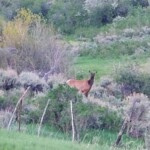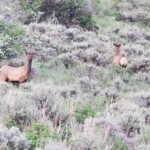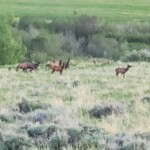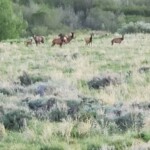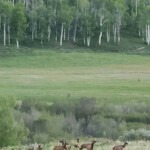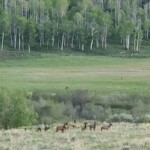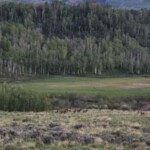What to wear especially to avoid blisters:
If you have questions or would like to check availability, call 970.926.0216 or complete the contact form.
Welcome to Bear Country

When you head out into Colorado’s great outdoors, you’re heading into country that’s long been home to black bears. With so many people spending time in bear country, human-bear conflicts are on the rise.
When people let bears get into food and garbage, the lure of an easy meal can overcome a bear’s natural wariness of people. Once bears learn to follow their super-sensitive noses camp sites and picnic grounds, they can damage property and even break into cars and campers. Black bears are not naturally aggressive, but they are strong, powerful animals. A bear intent on getting a meal can easily injure someone who gets in its way. Every year bears that have become too comfortable around people have to be destroyed.
Black Bears at a Glance
Black is a species, not a color. In Colorado many black bears are blonde, cinnamon, or brown.
- With their bulky fur coats, bears can look bigger than they are. Males average 275 lbs.; females average 175 lbs.
- Over 90% of a bear’s natural diet is grasses, berries, fruits, nuts and plants. The rest is primarily insects and scavenged carcasses.
- Black bears are very wary of people and other unfamiliar things. Their normal response to any perceived danger is to run away or climb a tree.
- Most Colorado bears are active from mid-March through early November. When food sources dwindle they head for winter dens.
- With a nose that’s 100 times more sensitive than ours, a bear can literally smell food five miles away.
- Bears are very smart, and have great memories – once they find food, they come back for more.
- During late summer and early fall bears need 20,000 calories a day to gain enough fat to survive the winter without eating or drinking.
- Bears are not naturally nocturnal, but sometimes travel at night in hopes of avoiding humans.
- Most camp sites west of 1-25 are in bear country. Bears that learn that people have food routinely visit camp sites, picnic areas and resorts in hopes of finding an easy meal.
If you want to avoid problems for yourself and the bears, make sure there’s nothing to attract bears to your camp.
- Stash Your Trash. Use bear-proof containers when available. If they’re full, double bag trash and lock it in your trunk or RV. Never leave trash outside.
- Store Attractants Safely. Store food, beverages and toiletries in air tight containers and lock in your trunk. Many bears have discovered that coolers, bags and boxes are full of food; never leave them in your tent or anywhere a bear could see, smell or reach.
- Keep a Clean Camp. Bears are attracted to odors of all kinds and will investigate anything interesting in hopes of finding food.
- Keep a Clean Tent. Don’t bring anything with an odor into your tent—that includes all foods, beverages, scented toiletries, gum, toothpaste, sunscreen, candles, and insect repellant. Don’t sleep in the clothes you cooked in; store them with your food.
- Lock RVs and Vehicles. Close windows and lock your vehicle and RV when you leave your camp site and at night before you go to sleep.
If a bear comes into camp, try to chase it away. Yell, toss small stones in the direction of (not directly at) the bear, bang pots and pans, or blow your car horn, air horn, or whistle. Make sure the bear has an escape route.
When you are backpacking or camping in an undeveloped area, set up a bear-safe camp to protect your food and avoid attracting bears. If there are signs a bear has visited the area recently, leave and choose another camp site.
Bear spray is a super-concentrated, highly irritating pepper spray proven to be more effective than firearms at deterring bears, but it’s no substitute for taking all the proper precautions to prevent problems in bear country.
Hitting the Trail
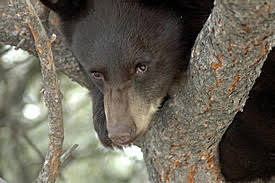
Bears will usually smell or hear you and leave the area long before you see them. Understanding bears’ natural behavior can help you avoid surprising a bear.
- Tracks, bear scat, and shredded logs are all signs you’re in bear country.
- Be alert at all times, and leave your headphones at home. Be extra cautious at dawn and dusk, when the wind is in your face, visibility is limited or you’re walking by a noisy stream. A firm clap or quick shout warns bears that humans are in the area.
- In late summer and fall, bears need to forage up to 20 hours a day, so avoid trails that go through berry patches, oak brush and other natural food sources.
- Keep dogs leashed
- Keep children between adults, and teach them what to do if they see a bear. Don’t let them run ahead or fall behind.
- Double bag food, and never leave any trash or leftovers behind. Finding treats teaches bears to associate trails with food.
- Never approach bears or offer food.
- Black bears are highly intelligent, with individual responses to people and situations. Wild black bears seldom attack unless they feel threatened, cornered, or are provoked.
- If You Surprise a Bear on a Trail
- Stand still, stay calm and let the bear identify you and leave. Talk in a normal tone of voice. Be sure the bear has an escape route.
- Never run or climb a tree.
- If you see cubs, their mother is usually close by. Leave the area immediately.
- If the Bear Doesn’t Leave
- A bear standing up is just trying to identify what you are by getting a better look and smell.
- Wave your arms slowly overhead and talk calmly. If the bear huffs, pops it jaws or stomps a paw, it wants you to give it space.
- Step off the trail to the downhill side, keep looking at the bear and slowly back away until the bear is out of sight.
- If the Bear Approaches
- A bear knowingly approaching a person could be a food-conditioned bear looking for a handout or, very rarely, an aggressive bear. Stand your ground. Yell or throw small rocks in the direction of the bear.
- Get out your bear spray and use it when the bear is about 40 feet away.
- If you’re attacked, don’t play dead. Fight back with anything available. People have successfully defended themselves with pen knives, trekking poles, and even bare hands.
Protect the Land You Came to Enjoy
Keep dogs leashed
If you are bringing your dog, it needs to be under immediate voice control or leashed at all times.
